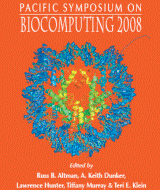Analysis of Large-Scale Sequencing of Small RNAs
A.J. Olson, J. Brennecke, A.A. Aravin, G.J. Hannon, R. Sachidanandam
Cold Spring Harbor Laboratory, 1 Bungtown Road, Cold Spring Harbor,NY 11724, USA
E-mail: ravi.cshl.work@gmail.com
Pac Symp Biocomput. 2008;:126-136.

Abstract
The advent of large-scale sequencing has opened up new areas of research, such as the study of Piwi-interacting small RNAs (piRNAs). piRNAs are longer than miRNAs, close to 30 nucleotides in length, involved in various functions, such as the suppression of transposons in germline 3,4,5. Since a large number of them (many tens of thousands) are generated from a wide range of positions in the genome, large-scale sequencing is the only way to study them. The key to understanding their genesis and biological roles is efficient analysis, which is complicated by the large volumes of sequence data. Taking account of the underlying biology is also important. We describe here novel analyses techniques and tools applied to small RNAs from germ cells in D. melanogaster, that allowed us to infer mechanism and biological function.
[Full-Text PDF] [PSB Home Page]